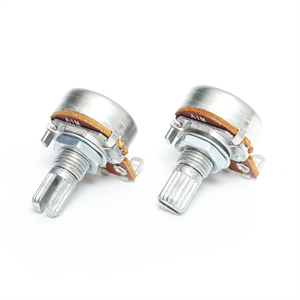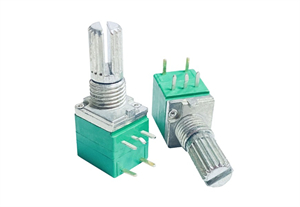What Is A Potentiometer
As a fundamental yet crucial element in the realm of electronic components, the potentiometer stands out. Its unique working principle and expansive application spectrum render it an essential in both designing and maintaining electronic equipment. Delving into the nuances of its principle, function, classification, and comparison with other components, this article also explores the taper characteristics and key technical specifications of potentiometers. It aims to furnish a comprehensive, in-depth understanding.
Catalog

1. Principles and Functions of Potentiometers
In the domain of analog signal processing, potentiometers assume a critical role. They enable precise control and measurement of voltage, thanks to their adjustable resistance principle. Consider the versatility: applications vary from volume control in audio amplifiers to the functionality in battery-operated portable devices. A potentiometer operates on the principle of adjustable resistance. Inside, a resistive material lines a path—straight or curved. A sliding joint, the vernier, physically contacts this resistor and can traverse the path. The user alters the resistance value between the cursor and the potentiometer by adjusting the cursor's position, achieving continuously adjustable control of the output voltage.
A potentiometer is adept at accurately measuring potential difference - the voltage between two points. It operates via the voltage division principle. This principle involves dividing the input voltage into distinct levels, a process pivotal in analog signal processing. For instance, in an audio amplifier, adjusting the volume is achieved by altering the amplifier's input signal voltage level using a potentiometer.
The passive nature of potentiometers is notable. They require no additional power source, a feature especially beneficial in battery-powered portable devices. This passive trait also implies that the potentiometer introduces no extra power consumption in the circuit, aside from the minimal power loss due to its inherent resistance.
2. Classification of Potentiometers
Potentiometers are bifurcated into analog and digital, based on their adjustment mechanism. Analog variants employ a physical sliding mechanism, such as a linear slider or rotary knob, to modify resistance. Linear potentiometers typically adopt a straight bar design, with a slider moving along a linear path. Rotary potentiometers, conversely, have a fixed axis and alter resistance via a rotating knob. Digital potentiometers, on the other hand, leverage digital signals (like pulse width modulation or a digital interface) for resistance adjustment. Suited for digital control systems, such as those governed by microprocessors, digital potentiometers afford more precise control. They are frequently employed in applications demanding high-precision adjustment.
In choosing a potentiometer, factors like resistance range, durability, temperature stability, and physical size come into play. For example, rotary potentiometers are often preferred in space-limited applications due to their compact design.

3. Comparison of Potentiometers with Other Related Components
Potentiometers and rheostats, despite their similar appearance, diverge significantly in function and application. Potentiometers are typically harnessed for voltage regulation, notably as voltage dividers in signal modulation. Imagine adjusting an audio signal to the precise level an amplifier requires. In contrast, rheostats find their use more in current limitation or in tweaking a circuit's total resistance.
Exploring their structure, a potentiometer usually features three terminals: a sliding end (wiper) and two stationary ends. Its role shifts based on terminal usage. Employing all three, it becomes a voltage divider. Using just the wiper and one fixed terminal, it transforms into a rheostat. Unlike rotary encoders, which generate digital signals and are prevalent in precision control systems like robots and high-precision positioning systems, potentiometers provide a continuous analog output. These systems necessitate additional circuitry to decode the rotary encoder's output.
4. Taper of Potentiometer
The taper of a potentiometer is pivotal. It defines the resistance change relative to the slider or knob's position. Linear taper potentiometers offer a steady resistance change throughout the entire adjustment range, fitting perfectly for standard applications, such as signal gain control. Conversely, the resistance change in a logarithmic or audio taper potentiometer is not linear, but logarithmic. This results in less resistance change at the start of the slider or knob's movement and more towards the end. Such a characteristic is particularly beneficial for audio applications like volume adjustments, aligning well with the human ear's logarithmic perception of sound intensity.
Beyond these two primary types, potentiometers come in other special tapers—inverse logarithmic, S-shaped, and custom tapers—each tailored for specific application needs.
5. Select Key Technical Indicators of Potentiometer
When choosing a potentiometer, several key parameters demand attention. The resistor value range, for instance, determines the maximum and minimum adjustable resistance and should align with circuit requirements. Next, consider the power rating – the maximum power a potentiometer can endure. This factor is crucial to prevent overheating under heavy loads.

Resolution is another vital aspect. It refers to the smallest change in resistance a potentiometer can detect, pivotal for applications needing precise control. Alongside, sliding noise, the resistance change noise during operation, becomes crucial, particularly in audio applications where it might directly impact sound quality. Equally important is the temperature coefficient, reflecting how resistance varies with temperature changes, a critical factor in environments experiencing significant temperature fluctuations.
Physical size and durability also play a part. Selection should be based on available installation space and the usage environment. In the same vein, operating voltage, frequency response, and insulation resistance are considerations not to be overlooked. For example, in high-frequency applications, a potentiometer's parasitic capacitance might influence its performance. Durability, especially in settings prone to mechanical wear, is a paramount factor.
6. Conclusion
In summary, potentiometers are not only vital in the electronic components industry, but their varied types and applications also make them an indispensable element in electronic design and maintenance. Selecting a suitable potentiometer involves carefully weighing technical indicators like resistance range, power rating, resolution, sliding noise, temperature coefficient, and physical dimensions and durability. These considerations ensure the chosen potentiometer aligns seamlessly with specific application needs and environmental conditions.